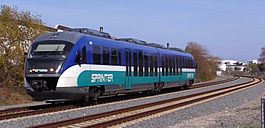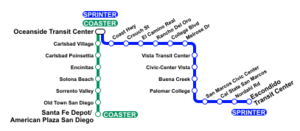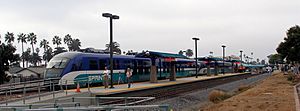Sprinter (rail service) facts for kids
Quick facts for kids SPRINTER |
|
|---|---|

A Sprinter train near College Blvd. in July 2020
|
|
| Overview | |
| Owner | North County Transit District |
| Locale | North San Diego County, California, United States |
| Termini | Oceanside Transit Center Escondido Transit Center |
| Stations | 15 |
| Service | |
| Type | Hybrid rail |
| System | North County Transit District |
| Depot(s) | Escondido Storage and Maintenance Yard |
| Rolling stock | 12 Siemens Desiro |
| Daily ridership | 3,500 (weekdays, Q1 2023) |
| Ridership | 1,364,400 (2022) |
| History | |
| Commenced | 2005 |
| Opened | March 9, 2008 |
| Completed | November 28, 2007 |
| Technical | |
| Line length | 22 miles (35 km) |
| Number of tracks | Single: 56% Double: 44% |
| Character | At-grade on exclusive right-of-way |
| Track gauge | 4 ft 8 1⁄2 in (1,435 mm) standard gauge |
| Operating speed | 50 mph (80 km/h) (top) 25 mph (40 km/h) (average) |
The Sprinter is a special kind of train service. It runs in the North County area of San Diego County, California. This train connects the cities of Escondido and Oceanside, United States.
The Sprinter uses a 22-mile (35 km) long train track called the Escondido Branch. It has 15 stations along the way. These stations serve cities like Oceanside, Vista, San Marcos, and Escondido. The train also helps students get to California State University, San Marcos and Palomar College.
Trains run every 30 minutes. The Sprinter is mostly for students and people who travel to work. The North County Transit District (NCTD) runs the Sprinter. They also operate other public transport like the Coaster commuter train and BREEZE buses. At the Oceanside Transit Center, you can connect from the Sprinter to other train lines. These include the Coaster, Metrolink, and Amtrak's Pacific Surfliner regional train.
In 2007, a study thought the Sprinter would reduce car trips by 5,000 each day. It also predicted over 11,000 train rides per day in its first year. After it opened, the number of riders grew. By March 2008, nearly 8,000 people were riding the Sprinter every day.
Contents
Sprinter Train History
The Sprinter is the first passenger train service on the Escondido Branch since 1946. Back then, the Santa Fe Railroad stopped its passenger service. The original train line was built in 1888. It had to be rebuilt to handle more trains. It was also raised higher because it runs along a river.
Money for the Sprinter came from a special tax called TransNet. Voters in San Diego County approved this tax in 1987. It was meant to help with traffic problems. A big part of the tax money was used for public transport. The whole project cost $477 million. The Federal Transit Administration also gave $152 million.
NCTD bought the train line in 1992 from the Santa Fe Railroad. Construction on the Sprinter line started in 2005. It was supposed to finish in December 2007. The Sprinter had a special preview on December 28, 2007. Regular service was planned for January 13, 2008. But the opening was delayed because of safety concerns. It finally started running on March 9, 2008.
In 2005, the Sprinter was the cheapest train project per mile in California. The American Public Works Association (APWA) gave the Sprinter an award. It was named the Transportation Project of the Year for projects over $75 million.
How the Sprinter Service Works
The Sprinter runs every 30 minutes. It goes in both directions, seven days a week. It starts around 4 am and runs until about 9 pm. On Friday and Saturday nights, trains run later. They go until about 10:30 pm (towards Oceanside) and 11:30 pm (towards Escondido). On Saturdays, Sundays, and holidays, trains run every 30 minutes between 10 am and 6 pm. They run once an hour before 10 am and after 6 pm.
Sprinter Stations
The Sprinter has 15 stations in total. This includes the first station in Oceanside and the last station in Escondido. Three of these stations are major transit centers. These are the Oceanside Transit Center, Escondido Transit Center, and the Vista Transit Center station.
| Location | Station | Connections |
|---|---|---|
| Oceanside | Oceanside Transit Center | |
| Coast Highway | ||
| Crouch Street | ||
| El Camino Real | ||
| Rancho Del Oro | ||
| College Boulevard | ||
| Melrose Drive | ||
| Vista | Vista Transit Center | |
| Civic Center–Vista | ||
| Buena Creek | ||
| San Marcos | Palomar College | |
| San Marcos Civic Center | ||
| Cal State San Marcos | ||
| Escondido | Nordahl Road | |
| Escondido Transit Center |
Sprinter Fares and Tickets
A single ride on the Sprinter costs $2.50. For seniors (60+), people with disabilities, or those with Medicare, it costs $1.25. Children under 5 years old ride for free. Up to three children can ride free with one adult.
You can also buy passes for unlimited travel. These include a 24-Hour Pass or a 30-Day Pass. These passes work on the Sprinter and other NCTD and MTS systems. This includes the San Diego Trolley and Breeze and MTS buses. For rides on the Coaster commuter train and express buses, you need a "RegionPlus" pass.
Pronto Fare System
The Sprinter uses a modern ticket system called Pronto. This system started in September 2021. It replaced the older Compass Card system. With Pronto, you "tap-on" when you enter the station platform. You use a special machine called a validator. Then, you "tap-off" when you arrive at your stop. This makes sure you pay the correct amount. You can buy physical Pronto cards at vending machines at NCTD stations. You can also get them at customer service centers. Digital versions are available online or through mobile apps.
Sprinter Ridership Numbers
Before the Sprinter opened, studies predicted about 11,000 weekday riders. In 2012, the average weekday ridership was 7,800. This was about 70% of the first prediction. For the whole year 2012, about 2.4 million people rode the Sprinter. In early 2013, the average weekday ridership grew to 8,500. This was 77% of the original daily prediction.
Sprinter Trains: Rolling Stock
The Sprinter uses special trains called Desiro-class diesel multiple units (DMUs). These trains were made by Siemens in Germany. They are often used for regional train lines. Twelve sets of these trains arrived in Escondido in August 2006. They were tested in California in early 2007. These passenger trains cannot run on the same tracks at the same time as freight trains. This is because they don't meet certain safety rules for freight lines. So, freight trains are not allowed when passenger trains are running.
Future Plans for Sprinter Service
The Sprinter is a fairly new train service. Future plans focus on making trains run more often. The goal is to have a train every 20 minutes. Right now, they run every 30 minutes. To do this, more of the Sprinter track needs to have two lines (double-tracking). Currently, only 9.6 miles (44%) of the track has two lines.
A project is planned to add more double-tracking. This would be around Crouch St. station through College Blvd. station. It would also be around Palomar College station through Nordahl Rd. station. This project is expected to take six years to finish.
In December 2022, NCTD received $7 million in funding. This money will help with the SPRINTER Corridor Service Improvement Project. This project has two parts. The first part will update the signal and communication systems. This will make the line safer and reduce delays. The funding also aims to reduce train service to every 15 minutes.
NCTD also wants to add a Sprinter Express train service. This express train would only stop at five main stations. These are Oceanside Transit Center, El Camino Real, Vista Transit Center, San Marcos Civic Center, and Escondido Transit Center. The Express service would use a different track east of San Marcos Civic Center. This would help trains travel faster between the start and end points.
For the longer term, there's a plan to extend the Sprinter by 2050. This extension would go south from the Escondido Transit Center. It would likely go to the Escondido Westfield Mall/Del Lago Transit Center. Other possible extensions, like to the San Diego Zoo Safari Park or McClellan–Palomar Airport, are not part of this plan.
Sprinter Challenges
The Sprinter has faced some complaints in northern San Diego County. For example, some business owners in Oceanside blamed the Sprinter for flooding in 2007 and 2008. They said that building the train line raised the tracks and made creeks narrower. Some people also complained about the limited train schedule. Because of this, NCTD added later trains on Friday and Saturday nights in 2011. The last trains now leave Escondido (westbound) at 10:33 pm and Oceanside (eastbound) at 11:33 pm.
Sprinter Service Pause in 2013
On February 28, 2013, the California Public Utilities Commission checked the Sprinter trains. They found that the brakes on all 12 trains were wearing out too quickly. Because of this, NCTD stopped all Sprinter service on March 8, 2013. NCTD provided bus service to replace the trains during this time. The train service was paused for 70 days. The Sprinter started running normally again on May 18, 2013. The special bus service ended on May 24.
See also
 In Spanish: NCTD Sprinter para niños
In Spanish: NCTD Sprinter para niños
- Transportation in San Diego County
- Coaster (commuter rail)
- San Diego Trolley




